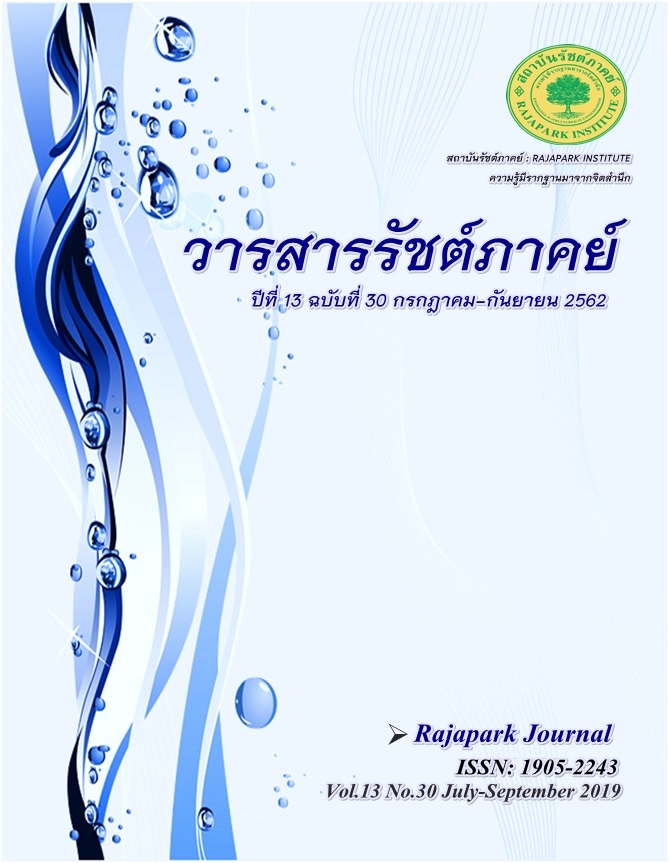The relationships between the level of quality of work life, Organizational commitment and the work behavior of employees at the Provincial Waterworks Authority
Main Article Content
Abstract
In this dissertation, the researcher examines the relationships between the level of quality of work life, organizational commitment and the work behavior of the employees at the Provincial Waterworks Authority (PWA). The research instrument to collect data was a questionnaire. The structural equation model (SEM) was used to prove the relationships of the variables. After the analysis of the quantitative data, the researcher collected data from interviews with 15 administrators in order to obtained additional information to discuss the research findings for the benefits of the organization in the future. Findings could be summarized as follows. The quality of work life exhibited a causal relationship and a direct effect on the organizational commitment. Organizational commitment exhibited a causal relationship and had a direct effect on the work behavior. Also the quality of work life exhibited a causal relationship and an indirect effect on the work behavior through the organizational commitment. It can be concluded that if the organization needs employees to have good work behavior, it should be enhanced to include an organizational commitment as well.
Article Details
Views and opinions appearing in the Journal it is the responsibility of the author of the article, and does not constitute the view and responsibility of the editorial team.
References
commitment to the organization. Journal of Occupational Psychology, 63(1), 1-18.
Bluestone, I. (1997). Organization Citizenship Behavior Among Hospital Employees: A Multidimensional Analysis
Involving Job Satisfaction and Organizational Commitment. Hospital & Health Services Administration,
42, 221-262.
Chaiyasaeng, S. (2011). Relationship between Quality of Work Life toward Organizational Commitment of
Ratchaphruek College’s Personnel. Center for research and Development, Ratchaphruek College.
Cohen A. (2003). Multiple Commitments in the Workplace: An integrative Approach. London: Lawrence Erlbaum
Associates Publishers.
Koopsman, L. et al. (2011). Conceptual Frameworks of Individual Work Performance: A systematic Review.
Journal of Occupational and Environmental Medicine, 53(8), 856-866.
Maslow, A. H. (1943). A theory of human motivation. Psychological Review, 50(4), 370-396.
Mathieu, J. E. & Zajac, D. M. (1990). A Review and Meta-Analysis of the Antecedents, Correlates, and
Consequences of Organizational Commitment. Psychological Bulletin, 108(2), 171-194.
Morrow, P. C. (1993). The Theory and Measurement of Work Commitment. Greenwich, CT: Jai Press Inc.
Noinakorn, J. (2008). The relationship between quality of work life, organizational commitment of company
employees in Rojana Industrial Estate, Phra Nakhon Si Ayutthaya Province. Master of Public
Administration Thesis, Urban and rural community development and management, Uttaradit Rajabhat
University.
Pitakthepsombut, P. (2009). Job satisfaction and organizational commitment. (2nd ed.). Bangkok: Sema Dharma.
Promthananon, T. (2008). Quality of work life and organizational commitment of commercial bank customer
service officers in Bangkok. Master of Industrial Education Thesis, King Mongkut's Institute of Technology
Ladkrabang.
Provincial Waterworks Authority. (2017). Sustainability Report 2017. Retrieved March 9, 2019, from
https://www.pwa.co.th/contents/files/service/annualreport /SustainabilityReport2017.pdf
Steers, R. M. (1977). Antecedents and outcomes of organizational commitment. Administrative Science
Quarterly, 22(1), 46-56.
Walton, R. E. (1974). Improving the Quality of Work Life. Harvard Business Review, 15(5), 12-16.

